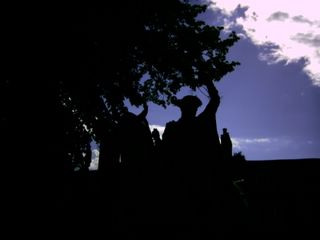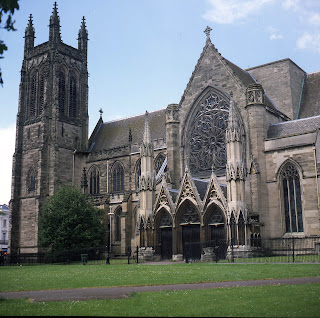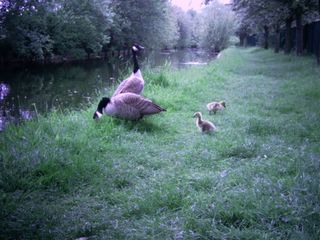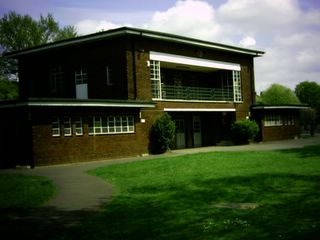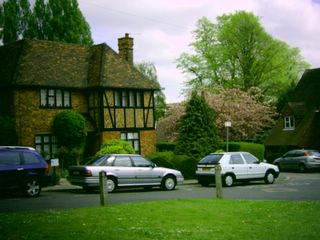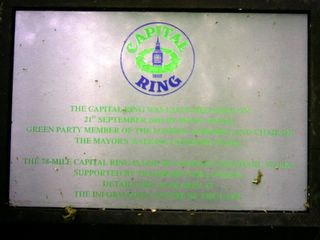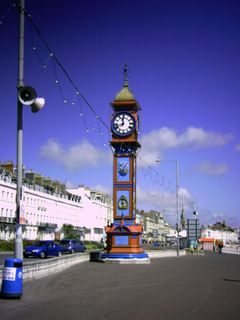Ups and downs, success but not very good success: I have now completed the capital ring!
For walk 13 (and part of 14), Sunday 21st May 2006 I got to Stoke Newington, Cazenove road by a rather unpleasantly full bus. The walk is not well signed here with a few signs missing in the earlier parts of the walk, but what made this walk really unpleasant was the rain which came down in torrents when I was nowhere near a bus stop and dried up when I was. That and some of the depressing areas the walk leads through. April showers in May forsooth. Anyway I walked through some boring suburban streets peopled with patriarchal types, this being the Chassidic Jewish quarter.
As I entered a street called Springfield I saw a place I knew from College, Lea view House. I studied it for my housing management exams. It had been built in the 1930s as a slum clearance scheme with excellent amenities such as tennis courts for the tenants. It had fallen into disrepair and worse and was refurbished as a pioneer in community involvement. It looks as though it is still thriving. The Estate Manager’s name at the time of the refurbishment was Dick Head. You can get a film about it all should you be so inclined.
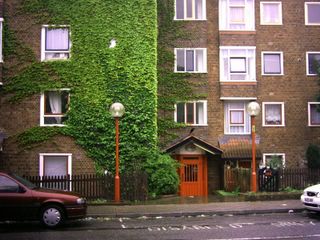
Lea View House

Springfield Park of 33 acres looked very pleasant and I’m inclined to go and do this walk again (from there) as there was a park café and (allegedly) a conservatory and bandstand all with views towards the River Lee. Rain rather stopped play here so I just carried on across the River Lee by bridge where I could not get my camera and gadget bag through the bollards. A really portly person could not have done it at all – is Lee Valley Regional Park fattist? I walked through the Walthamstow Marshes blinded by the rain and sheltered under Railway arches which were where A V Roe made the first all British powered flight in a triplane, the Yellow Terror, in 1909. This is commemorated by a plaque which I could not see. The next part of the walk past a trim track in a local park was closed but with the fencing down and already wet through I decided to chance it. The Middlesex water filter beds were on this stretch, which is something else I’d like to see but had to give it a miss.
I passed Hackney Marshes with its 80 football pitches and the Lesney Matchbox toy factory (which does not seem to be used for that anymore) on the river at Homerton Road. Here the rain got so bad I left the route to wait for a bus but no bus came and the rain eased off so I just carried on. The Lee here is broad and wide. Inconsistent spellings are intentional – natural features are lee, manmade are lea. Who am I to argue with the Park Authority?
The Eton Mission Boat house commemorating Mr Johnstone was built in 1934 and still provides rowing and canoeing facilities for east Londoners.
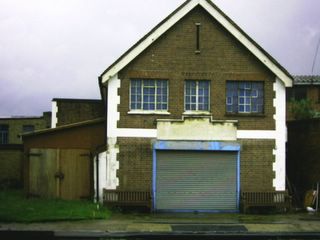
Eton Mission Rowing Club

I missed the turn off the route here and carried on to do part of Walk 14. I walked past the junction with the Hertford Union Canal where a new block of flats has been built. Quite nice! Continuing (still in the rain) to Old Ford Lock there was a party, which appeared to be doing the route in the opposite direction (widdershins).
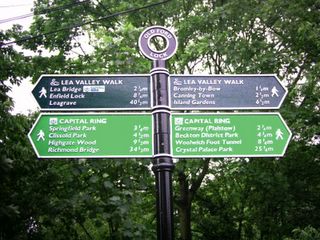
Capital ring sign old ford lock

I then went onto the Greenway, which is really the mound that covers the Northern Outfall Sewer which discharges London’s waste water into the river for carrying away at high tide. Designed by Joseph Bazalgette in the 1860s like all London’s waterworks they are still doing the same job as they ever did for a larger population that likes getting washed more often than their ancestors did, and has more baths, basins and toilets than the were the norm in the mid 19th century. It’s all rather a strain. Investment in new supplies now please – and Ken that desalination plant sounds attractive, although you want us to grow cactuses in our window boxes. Let it through!!

This path went through an area of rubbish dumps and dirty industry, most of which backed the bid for London 2012. I suppose their businesses are worth more as land for development than the business is worth. Pity, because if we can’t add value to something we can’t afford anything.
I left the walk for that day at Stratford High Street.
As the next day 22nd May 2006 dawned bright and sunny towards the East I headed off again to Stratford to rejoin the walk. Unfortunately it dulled in again so although not as bad as previously still pretty grim walking. At the start of today’s walk was a block of flats called Albert Bigg Point. Does this person live in the block? If so can I meet him?
There was a human sundial set into the ground on the meridian line. I could not check it for accuracy due to lack of sunlight!
I crossed some of the Bow Thames Backwaters- navigable rivers to the Thames and passed Abbey Mills Pumping Station built to pump sewerage from the Northern Outfall sewer to the Thames. This was a curious blend of large Victorian house with an ornate porch and a public building of some sort with a Moorish turret. Moorish seems to be an architecture well used for sewerage. At the Channelsea river there is this piece of sculpture – part of the machinery from Abbey Mills.
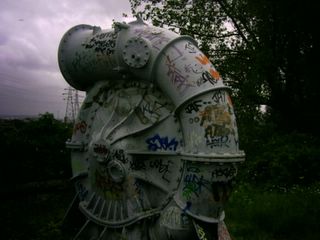
Machinery from Abbey Mills

The Greenway is not interesting walking although I did have to use my ingenuity to scramble over some pointed poles to get out where Newham Parks Dept had not unlocked the gate at one end of the strip. I checked my trousers and there were no punctures, I’m pleased to say.
After the greenway the walk led me to a view of Beckton Alps. Beckton was named after Beck, chief engineer to the Gas Light and Coke Company (the GLCC), who laid out a new town around the refraction plant. Superseded by North Sea Gas in the 1970s this became redundant and the Beckton Alps are the slagheaps from the plant. They do look like Alps though. After this I went into Beckton District Park with loads of waterfowl all with chicks. Two swans with three chicks, several geese with many chicks. Not that all will reach maturity but a lot will. The park was pleasant enough with identified trees and moderately well kept. I decided to go on to Walk 15 to finish what I began three months ago.
This was by far the least interesting part of the ring. Most of the walk was in scrubby parkland or housing estates, even the bits by the river with good views were not so interesting.
I did visit the University of East London Campus but rain again stopped play there. However wonderful it is it will never be great in the driving rain. The views from the riverside included the RACS former central premises clock (You’ll have to visit my other blog to see that one) and the free ferries. The day was against me for seeing the railway museum at North Woolwich (once part of the Borough of Woolwich) as this only opens on weekends.
The Woolwich Foot Tunnel was opened in 1912 and confusingly has two entrances: one for stairs and the other for lifts. I took the lift, although unlike the Greenwich Foot Tunnel these lifts are small and have no seats in them. Perhaps the Woolwich Tunnel was built when the Moderates were in power on the LCC and the Greenwich one when the Progressives were in power.
The Picture shows the gloomy Woolwich tunnel.
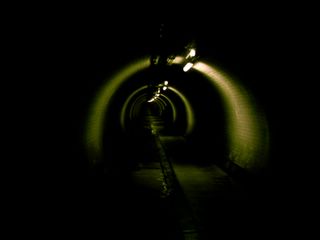
Subterranean Gloom- Woolwich foot tunnel

I completed the walk with a sigh of relief. For a moment I reflected on the walks I would do again. Certainly 4, 7, 12 and 13 which have been the highlights. Never again will I do 14 and I probably won’t do 9 again either.
Now for the London Loop…
